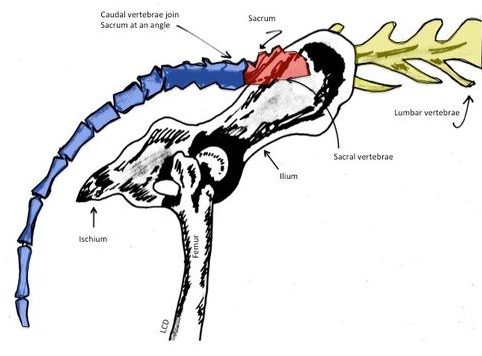Let’s face it. Some dogs’ tails are downright dangerous – so strong as they thwack against you. But how can you get mad at a wagging tail on a happy dog, even if it leaves a bruise on your thigh? Unfortunately, dogs sometimes wag their tails so much they damage muscles that control tail movement. Other times they knock them against really hard surfaces to cause bleeding. The former is called limp tail, the latter is happy tail. Both are discussed in this week’s post. Happy reading!

What are limp tail and happy tail?
Tails are composed of a variable number of bones called caudal vertebrae. Tails have several muscles, a great blood supply, many sensitive nerves, and a thin layer of skin. This anatomy combined with the force of wagging creates a prime scenario for tail injuries.

Happy tail: While’s it’s true some dogs smile with their mouths, all dogs smile with their tails. That is, when they’re happy, they wag their tails to tell us they’re happy. Happy tail arises when dogs bash their tails against walls, doors, kennels, and other surfaces until they start to bleed.
Limp tail: Also known as swimmer’s tail, this injury happens when dogs use their tails so much they injure muscles that control tail movement. When tails have been overworked for whatever reason, dogs are reluctant to wag them because of intense pain. Less common causes of limp tail are traumatic accidents (i.e.: getting caught in a door), bite wounds, lacerations, and anal gland disorders.
What do they look like?
Happy tail: When the skin of the tail is compromised, hemorrhage occurs. The bleeding doesn’t have to be excessive to make it look like a murder scene. Wagging helps spray blood all over the place. There is no age or sex predilection, but large and giant breed dogs seem to be over-represented, particularly Labrador retrievers.

Limp tail: When dogs overwork their tails, muscles are injured creating discomfort. Dogs understandably restrict the movement of their typically wagging appendages. The tails are typically limp and flaccid, and they may be swollen too. Due to pain, many dogs often lick and/or chew their tails. Interestingly, clinical signs are more commonly noted after vigorous exercise in cold, wet weather. Just as for happy tail, large and giant breed dogs are over-represented but there is no age or sex predilection.
How are they diagnosed?
Making a diagnosis of both happy tail and limp tail is straightforward. Happy tails are bleeding or have bled. Not only is there evidence of bleeding in the areas in which the dogs were housed, there are also injuries – most commonly lacerations and ulcers – visible on the tails. Dogs with limp tail typically have a history of recent rigorous exercise.
How is it treated?
Rest and appropriate pain management are the hallmarks of successful management of most cases of limp tail. For those with injuries other than overworked tail muscles, further intervention will be needed. On the other hand, happy tail requires intervention to address bleeding injuries. Dogs may require minor surgery to repair lacerations and ulcers. Antibiotics may be temporarily needed if wounds are infected, and preventing self-trauma with the use of Elizabethan collars (aka the “cone of shame”) is of paramount importance. Unfortunately, many dogs repeatedly injure their tails, and their wounds fail to fully heal. In these rare happy tail scenarios, partial or complete tail amputation may be necessary and recommended.
The take-away message about happy tail & limp tail in dogs…
Dogs use their tails for two major purposes: as a sort of rudder to help them turn precisely and to express social cues. Unfortunately, tails can also be damaged easily. Happy tail and limp tail are two types of injuries. Thankfully, prognosis is good for most dogs with these problems as long as they receive appropriate medical care.
Wishing you wet-nosed kisses,
CriticalCareDVM






